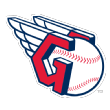CLEVELAND — As you roll into downtown Cleveland, there’s a pedestrian overpass across Ontario Street with a huge All-Star banner draped along the length of the bridge to promote the week’s festivities. It features the faces of several of baseball’s biggest stars.
One of those stars is Bryce Harper, the biggest name and most recognizable player in the sport.
The only problem, of course, is that Harper is not an All-Star. He’s not in Cleveland. He had a good first half, hitting .253/.370/.470 with 16 home runs and 62 RBIs. But it wasn’t a great first half, and for the first time since 2014, the fans did not vote him in as a starter. The players didn’t vote him in as a reserve and the league selected J.T. Realmuto as the Philadelphia Phillies‘ rep.
So no Harper in Cleveland. Christian Yelich and Cody Bellinger, putting together monster seasons, will start in the National League outfield alongside the Atlanta Braves‘ 21-year-old phenom, Ronald Acuna Jr. Harper was once that phenom, but now he’s a 26-year-old veteran with the expectations that come with a $330 million contract.
Harper’s numbers are down a bit from last season — an .889 OPS compared to .839 in 2019 — and he’s still on pace to hit 29 home runs. That’s fine, except everyone is hitting home runs now. Yelich and Bellinger have already reached 30. Harper is on pace to whiff 189 times, and when you’re striking out that much, you’re not going to hit .300 like Harper did in 2015 and 2017. His swing-and-miss rate continues to escalate, raising concern about his long-term level of production:
-
2017: 26.8 percent
-
2018: 31.4 percent
-
2019: 33.3 percent
It’s also half a season. He cut his strikeout rate in June. One hot streak and the overall numbers will look a lot better. He’s also not the only big name not here in Cleveland. Here are 10 more 2018 All-Stars who aren’t All-Stars in 2019 and what’s gone wrong:

Like Harper, Machado hit the $300 million jackpot in free agency. He’s actually the most deserving player on this list, hitting .266/.339/.489 with 20 home runs and 58 RBIs with his usual excellent defense. Machado’s numbers aren’t quite as good as last season (moving from Camden Yards to Petco Park doesn’t help), but he mostly got squeezed out at a loaded position, with Nolan Arenado, Anthony Rendon and Kris Bryant making it ahead of him at third base. The league then chose Max Muncy over Machado when Rendon pulled out of the game.

This might be the most perplexing story in baseball this season. Ramirez had finished third in the MVP voting the past two seasons but has inexplicably stopped hitting at that level, with a .218/.308/.344 line at the break. Really, his slump goes back to last season:
-
2017 through Aug. 17, 2018: .312/.392/.607, 66 home runs in 271 games (HR every 15.5 at-bats)
-
Aug. 18, 2018, through All-Star break: .202/.307/.322, nine home runs in 123 games (HR every 50.7 at-bats)
This type of sudden drop for a 26-year-old star in the prime of his career is basically unprecedented, barring injury. He has trouble catching up to fastballs (miss rate on fastball up from 6.1% last year to 10.3%) and after slugging .697 in 2017 and .668 in 2018 against fastballs, he’s at only .325 this season.

The National League starter at DH in the 2018 All-Star Game, it looked like a perfect match when the Cardinals acquired the unassuming six-time All-Star to anchor their lineup. Instead, he has fallen from a .922 OPS to .769. He has only 25 extra-base hits after lashing out 73 with the Arizona Diamondbacks. He has hit just .235 with .314 slugging with runners in scoring position.
What’s going on? This one is harder to figure out than Ramirez. All of his swing metrics — swing rate, miss rate, chase rate — are the same as in 2018. His strikeout and walk rates are about the same. His average exit velocity and launch angle are down a bit, so he’s not barreling up as many balls (more fly balls and fewer line drives). Maybe the move away from Arizona has hurt, except he had a 1.053 OPS on the road last season. Goldschmidt is 31, so his decline — if that’s what’s happening — is less startling than Ramirez’s (and not as severe).

Another six-time All-Star first baseman, Votto was the MVP runner-up as recently as 2017 but lost his power stroke last season, falling from 36 home runs to 12 (including just three in the second half). He still made the All-Star team thanks to a .422 OBP in the first half and led the league in the category at season’s end, but Votto has been unable to reverse his decline in power, entering the break with just eight home runs and a .268 average.
The number that stands out even more: Even last season, Votto finished with more walks than strikeouts. This year he’s at 72 strikeouts and 41 walks. Those who love Votto were hoping for a rebound, but at 35 it appears peak Joey Votto is clearly in the past. We all get old.

Nola had a breakout season and a monster first half in 2018, going 12-3 with a 2.30 ERA at the break. He ended up with a 2.37 ERA and finished third in the Cy Young voting. Riding that unhittable curveball, it was such a dominant campaign that it was easy to project Nola as a true No. 1 starter heading into 2019.
That hasn’t happened. He had a miserable start, allowing a combined 16 earned runs over his second, third and fourth starts, and he has been digging out of that statistical hole ever since. The good sign: Since April 25, he’s 5-2 with a 2.96 ERA and 90 strikeouts and seven home runs in 79 innings — the kind of results we saw last season. Let’s chalk April up to the cold weather in the Northeast. He’s not an All-Star, but he’ll end up the season with better numbers than several of the pitchers on the NL roster.

In spring training, Snell told me with complete sincerity that he believed he could do better than his 21-5, 1.89 ERA Cy Young season. He is not a man lacking in confidence. It was going to be almost impossible to match 2018, however, mainly because he held batters to a this-is-not-a-misprint .088 average with runners in scoring position.
To be fair, he has pitched better than his 4.70 ERA might indicate. His strikeout and walk rates are actually slightly better than 2018. Of course, that doesn’t hide that he’s still giving up more hits and more home runs (well, everyone is giving up more home runs). Some of that is bad luck with balls in play, some of that is the ball and the inability to spin his breaking stuff as consistently as last season (with the lower seams). The harder thing to explain is why he has had four blow-up starts of six-plus runs, allowing 26 runs in 11 innings in those four games. He’s too good to have that many poor outings. Still, the stuff is excellent and I’d expect him to be one of the better pitchers in the league the rest of the way.

For the sake of Mets fans’ sanity, I won’t publish Diaz’s numbers. But safe to say he’s blowing more games than he did last season with the Mariners, a season so good the Mets just had to have him and even took a large chunk of Robinson Cano‘s contract to acquire the flame-throwing closer.
Like many pitchers in 2019, Diaz’s strikeout rate is fine, but everything else has gone in the toilet. We can trace his problems to his slider, which was death to bats in 2018 and has been pummeled in 2019:
-
2018: .128/.188/.234, 56.4% strikeout rate
-
2019: .319/.353/.532, 33.3% strikeout rate
More than half of the plate appearances that ended with a slider last season ended in a strikeout. Diaz hasn’t had the same control or movement on the pitch, and hitters have made him pay.

Altuve started the past four All-Star Games at second base for the American League. While he’s hitting .262/.328/.453, those aren’t his usual numbers. He also has missed time with injury.
Still, a generation ago, the fans might have still voted Altuve into the All-Star Game. After all, this is one of the biggest stars in the game, a player everyone loves, and it’s not like he’s been terrible. No offense to DJ LeMahieu — who is having a great season for the New York Yankees and deserves to be an All-Star — Tommy La Stella, Whit Merrifield or Brandon Lowe, but the All-Star Game used to be about wanting to see the Altuves of the world. Things change. I guess we all get old.

Aaron Judge isn’t here because he missed too much time due to injury, and Posey’s struggles at the plate are almost certainly related to the surgery he had last August. Posey limps into the All-Star break with a .253/.315/.378 line and only three home runs in 217 at-bats. He’s only 32, but he’s a 32-year-old catcher coming off surgery to repair a torn labrum and a hip infringement. Given his age, the injuries and all of his innings behind the plate, who knows what the future holds for Posey. He’s a six-time All-Star, and I hope he gets back to another one.
Matt Kemp, unemployed
Believe it or not, Kemp started in left field for the National League last year. Fast forward a year and he might have played his last game in the major leagues after a short stint with the Reds during which he hit .200 with 19 strikeouts and one walk. He signed with the Mets and played eight games with Triple-A Syracuse, but he hasn’t played since June 8 due to back and rib issues. Maybe he’ll get back in the majors. Maybe not. But he’s yet another reminder that baseball can be cruel and unforgiving … even to All-Stars.
